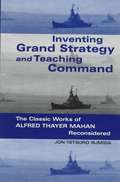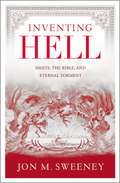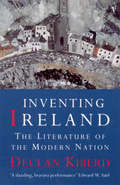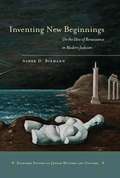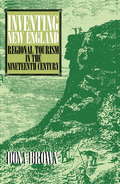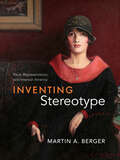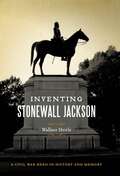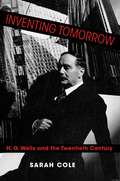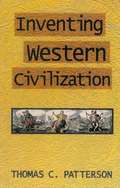- Table View
- List View
Inventing George Whitefield: Race, Revivalism, and the Making of a Religious Icon
by Jessica M. ParrEvangelicals and scholars of religious history have long recognized George Whitefield (1714-1770) as a founding father of American evangelicalism. But Jessica M. Parr argues he was much more than that. He was an enormously influential figure in Anglo-American religious culture, and his expansive missionary career can be understood in multiple ways. Whitefield began as an Anglican clergyman. Many in the Church of England perceived him as a radical. In the American South, Whitefield struggled to reconcile his disdain for the planter class with his belief that slavery was an economic necessity. Whitefield was drawn to an idealized Puritan past that was all but gone by the time of his first visit to New England in 1740.Parr draws from Whitefield's writing and sermons and from newspapers, pamphlets, and other sources to understand Whitefield's career and times. She offers new insights into revivalism, print culture, transatlantic cultural influences, and the relationship between religious thought and slavery. Whitefield became a religious icon shaped in the complexities of revivalism, the contest over religious toleration, and the conflicting role of Christianity for enslaved people. Proslavery Christians used Christianity as a form of social control for slaves, whereas evangelical Christianity's emphasis on "freedom in the eyes of God" suggested a path to political freedom. Parr reveals how Whitefield's death marked the start of a complex legacy that in many ways rendered him more powerful and influential after his death than during his long career.
Inventing Grand Strategy and Teaching Command: The Classic Works of Alfred Thayer Mahan Reconsidered
by Jon SumidaJon Sumida is a noted military historian of the 20th century with emphasis on naval developments. The first American works on this subject were those of Alfred T. Mahan and his Influence of Sea Power... books. Though considered out of date in the post WWI naval world, Dr. Sumida provides a new interpretation of these historical works.
Inventing Hell
by Jon M. SweeneyHell: The word means terror, darkness, and eternal separation from God. Some people think the Bible is clear about hell, but what if they're mistaken? With gripping narrative and solid scholarship, Sweeney charts hell's "evolution" from the Old Testament underworld Sheol, through history and literature, to the greatest influencer of all: Dante's Inferno. He reveals how the modern idea of hell is based mostly on Dante's imaginative genius-but in the process, he offers a more constructive understanding of the afterlife than ever before. Disturbing and enthralling, Sweeney will forever alter what we think happens to us after we die-and more importantly, he will make us reconsider how we live. Bible really says about heaven and hell, giving us a clearer, more hopeful understanding of the afterlife than ever before.
Inventing Herself: Claiming a Feminist Intellectual Heritage
by Elaine ShowalterSure to take its place alongside the literary landmarks of modern feminism, Elaine Showalter's brilliant, provocative work chronicles the roles of feminist intellectuals from the eighteenth century to the present. With sources as diverse as A Vindication of the Rights of Woman and Scream 2, Inventing Herself is an expansive and timely exploration of women who possess a boundless determination to alter the world by boldly experiencing love, achievement, and fame on a grand scale. These women tried to work, travel, think, love, and even die in ways that were ahead of their time. In doing so, they forged an epic history that each generation of adventurous women has rediscovered. Focusing on paradigmatic figures ranging from Mary Wollstonecraft and Margaret Fuller to Germaine Greer and Susan Sontag, preeminent scholar Elaine Showalter uncovers common themes and patterns of these women's lives across the centuries and discovers the feminist intellectual tradition they embodied. The author brilliantly illuminates the contributions of Eleanor Marx, Zora Neale Hurston, Simone de Beauvoir, Margaret Mead, and many more. Showalter, a highly regarded critic known for her provocative and strongly held opinions, has here established a compelling new Who's Who of women's thought. Certain to spark controversy, the omission of such feminist perennials as Susan B. Anthony, Eleanor Roosevelt, and Virginia Woolf will surprise and shock the conventional wisdom. This is not a history of perfect women, but rather of real women, whose mistakes and even tragedies are instructive and inspiring for women today who are still trying to invent themselves.
Inventing Ireland: The Literature of a Modern Nation
by Declan KiberdKiberd - one of Ireland's leading critics and a central figure in the FIELD DAY group with Brian Friel, Seamus Deane and the actor Stephen Rea - argues that the Irish Literary Revival of the 1890-1922 period embodied a spirit and a revolutionary, generous vision of Irishness that is still relevant to post-colonial Ireland. This is the perspective from which he views Irish culture. His history of Irish writing covers Yeats, Lady Gregory, Synge, O'Casey, Joyce, Beckett, Flann O'Brien, Elizabeth Bowen, Heaney, Friel and younger writers down to Roddy Doyle.
Inventing Japan
by Ian BurumaIn a single short book as elegant as it is wise, Ian Buruma makes sense of the most fateful span of Japan's history, the period that saw as dramatic a transformation as any country has ever known. In the course of little more than a hundred years from the day Commodore Matthew Perry arrived in his black ships, this insular, preindustrial realm mutated into an expansive military dictatorship that essentially supplanted the British, French, Dutch, and American empires in Asia before plunging to utter ruin, eventually emerging under American tutelage as a pseudo-Western-style democracy and economic dynamo.What explains the seismic changes that thrust this small island nation so violently onto the world stage? In part, Ian Buruma argues, the story is one of a newly united nation that felt it must play catch-up to the established Western powers, just as Germany and Italy did, a process that involved, in addition to outward colonial expansion, internal cultural consolidation and the manufacturing of a shared heritage. But Japan has always been both particularly open to the importation of good ideas and particularly prickly about keeping their influence quarantined, a bipolar disorder that would have dramatic consequences and that continues to this day. If one book is to be read in order to understand why the Japanese seem so impossibly strange to many Americans, Inventing Japan is surely it.From the Hardcover edition.
Inventing Latinos: A New Story Of American Racism
by Laura E. GómezWho are Latinos and where do they fit in America’s racial order? In this “timely and important examination of Latinx identity” (Ms.), Laura E. Gómez, a leading critical race scholar, argues that it is only recently that Mexican Americans, Puerto Ricans, Cubans, Dominicans, Central Americans, and others are seeing themselves (and being seen by others) under the banner of a cohesive racial identity. And the catalyst for this emergent identity, she argues, has been the ferocity of anti-Latino racism.
Inventing Laziness: The Culture of Productivity in Late Ottoman Society
by Melis HafezNeither laziness nor its condemnation are new inventions, however, perceiving laziness as a social condition that afflicts a 'nation' is. In the early modern era, Ottoman political treatises did not regard the people as the source of the state's problems. Yet in the nineteenth century, as the imperial ideology of Ottomanism and modern discourses of citizenship spread, so did the understanding of laziness as a social disease that the 'Ottoman nation' needed to eradicate. Asking what we can learn about Ottoman history over the long nineteenth-century by looking closely into the contested and shifting boundaries of the laziness - productivity binary, Melis Hafez explores how 'laziness' can be used to understand emerging civic culture and its exclusionary practices in the Ottoman Empire. A polyphonic involvement of moralists, intellectuals, polemicists, novelists, bureaucrats, and, to an extent, the public reveals the complexities and ambiguities of this multifaceted cultural transformation. Using a wide variety of sources, this book explores the sustained anxiety about productivity that generated numerous reforms as well as new understandings of morality, subjectivity, citizenship, and nationhood among the Ottomans.
Inventing Memory
by Anne HarrisA one-of-a-kind novel, like nothing you've ever read, Inventing Memory is a stunning blend of fantasy and reality, exposing the secret links between the mythic, the mundane, and the timeless mysteries of the human heart.Shula is a slave in fabled Sumer---until Inanna, Queen of Heaven, appears before her. Chosen by the Goddess for reasons she cannot begin to fathom, Shula is freed from bondage and set upon an uncertain path toward a new and mysterious destiny. But the attention of the gods is a dangerous thing, and Shula may have cause to regret the day she first laid eyes on the Holy Inanna.Wendy Chrenko, former high school misfit, is now an overworked graduate student, researching her dissertation "Remnants of Matriarchy in the Ancient Sumerian Inanna Cycle." Still smarting from the painful wounds of a failed love affair, Wendy is bound and determined to prove that men and women once lived together in perfect equality, even if it means volunteering for a bizarre and dangerous scientific experiment.Separated by millennia, Shula and Wendy appear to be two very different women, leading completely separate lives.Or maybe not.At the Publisher's request, this title is being sold without Digital Rights Management Software (DRM) applied.
Inventing New Beginnings
by Asher D. BiemannBiemann (modern Jewish thought and intellectual history, U. of Virginia) explores the multiple connotations of "renaissance" in relation to the Jewish Renaissance that suffused much of German- speaking Jewry between 1890 and the rise of Nazism in the late 1930s, partly as a backlash to the earlier assimilationist Jewish Enlightenment. Drawing on the thinking of Franz Rosensweig in the New Learning, Mircea Eliade, Hegel, Buber, and other philosophers on the meaning of time and beginnings, he argues that this movement was less a return to traditional Judaism than a renewal of self-awareness and questioning in the encounter with modernity. Annotation ©2009 Book News, Inc. , Portland, OR (booknews. com)
Inventing New England
by Dona BrownQuaint, charming, nostalgic New England: rustic fishing villages, romantic seaside cottages, breathtaking mountain vistas, peaceful rural settings. In Inventing New England, Dona Brown traces the creation of these calendar-page images and describes how tourism as a business emerged and came to shape the landscape, economy, and culture of a region.By the latter nineteenth century, Brown argues, tourism had become an integral part of New England's rural economy, and the short vacation a fixture of middle-class life. Focusing on such meccas as the White Mountains, Martha's Vineyard, Nantucket, coastal Maine, and Vermont, Brown describes how failed port cities, abandoned farms, and even scenery were churned through powerful marketing engines promoting nostalgia. She also examines the irony of an industry that was based on an escape from commerce but served as an engine of industrial development, spawning hotel construction, land speculation, the spread of wage labor, and a vast market for guidebooks and other publications.
Inventing New Orleans: Writings of Lafcadio Hearn
by S. Frederick StarrLafcadio Hearn (1850-1904) prowled the streets of New Orleans from 1877 to 1888 before moving on to a new life and global fame as a chronicler of Japan. Hearn's influence on our perceptions of New Orleans, however, has unjustly remained unknown. In ten years of serving as a correspondent and selling his writing in such periodicals as the New Orleans Daily Item, Times-Democrat, Harper's Weekly, and Scribner's Magazine he crystallized the way Americans view New Orleans and its south Louisiana environs. Hearn was prolific, producing colorful and vivid sketches, vignettes, news articles, essays, translations of French and Spanish literature, book reviews, short stories, and woodblock prints. He haunted the French Quarter to cover such events as the death of Marie Laveau. His descriptions of the seamy side of New Orleans, tainted with voodoo, debauchery, and mystery made a lasting impression on the nation. Denizens of the Crescent City and devotees who flock there for escapades and pleasures will recognize these original tales of corruption, of decay and benign frivolity, and of endless partying. With his writing, Hearn virtually invented the national image of New Orleans as a kind of alternative reality to the United States as a whole. S. Frederick Starr, a leading authority on New Orleans and Louisiana culture, edits the volume, adding an introduction that places Hearn in a social, historical, and literary context. Hearn was sensitive to the unique cultural milieu of New Orleans and Louisiana. During the decade that he spent in New Orleans, Hearn collected songs for the well-known New York music critic Henry Edward Krehbiel and extensively studied Creole French, making valuable and lasting contributions to ethnomusicology and linguistics. Hearn's writings on Japan are famous and have long been available. But Inventing New Orleans: Writings of Lafcadio Hearn brings together a selection of Hearn's nonfiction on New Orleans and Louisiana, creating a previously unavailable sampling. In these pieces Hearn, an Anglo-Greek immigrant who came to America by way of Ireland, is alternately playful, lyrical, and morbid. This gathering also features ten newly discovered sketches. Using his broad stylistic palette, Hearn conjures up a lost New Orleans which later writers such as William Faulkner and Tennessee Williams used to evoke the city as both reality and symbol.
Inventing Scrooge
by Carlo DevitoInventing Scrooge uncovers the real-life inspirations from Charles Dickens' own world that led to the fascinating creation of his most beloved tale: A Christmas Carol.When Charles Dickens conceived the story that would become A Christmas Carol, little did he know that his "ghostly little book" would reinvent the way we keep Christmas. From a graveyard in Edinburgh to the Marshalsea Prison in London to his schoolboy years in Chatham and even his lifelong fascination with dance, so much of Dickens' past and present are woven into the characters and themes of A Christmas Carol. And by understanding the story behind the story, readers will come to embrace the holiday classic all the more. To this day, we look to the Christmas season as a time of warmth and celebration among family, friends, and strangers alike. And every year at Christmas, not only do our lives get better for all the festivity, but we get better, as people. Just like Ebenezer Scrooge.e at a time, was not the way to reach his audience and spread his meaning. It was too piece meal and took too long. It was on this train ride to make this speech that the first ideas came to Dickens to instead, write a story that might advance his cause in a much more effective way. As the train lurched by the engine works at grimy Camden Town, Dickens thoughts must have tripped backwards in his mind, to a time in his youth, when he and his many brothers and sisters lived all jammed into a small home, where the Dickens family led a meager and lean life, as his father struggled with mounting debt. On this eight-hour ride, the seeds for one of his most famous stories came to life - A Christmas Carol. Dickens became obsessed by the story. He wrote that as the tale unfolded he 'wept and laughed, and wept again' and that he 'walked about the black streets of London fifteen or twenty miles many a night when all sober folks had gone to bed.' And almost every aspect of the story came to him as it pulled it from his life. * The nephew, Fred, who comes to see Scrooge is a carefree spirit, who lives what Scrooge considers to be a spendthrift existence, much like Dickens own brother Fred was in real life. * Fred is the son of Scrooge's sister, Fan. In real life, Dickens' favorite and closest sibling was Fran (or Fanny). * Tiny Tim was modeled on Dickens' nephew Henry Burnett Jr., who was small and handicapped. * The Cratchits were the Dickens family of Charles' youth. The Dickens lived in Camden Town, eight to a small, row house, with little money. * Much like Ebernezer Scrooge, Dickens own real life wife Catherine Hogarth, tried to break off their engagement citing that Dickens was more obsessed with making money than spending time with her. Dickens took up all these threads, and wove them into one of the most magical tales of all time. And it all came from this trip to Manchester.
Inventing Stereotype: Race, Representation, and Interwar America
by Martin A. BergerBerger excavates the lineage of stereotype as a concept, illustrating how perception of stereotypes in works of literature and fine art shifts relative to representational norms. Upending a century of scholarly and popular thinking about stereotype, Martin A. Berger traces our current understanding of it to the 1920s, when American journalist and public intellectual Walter Lippmann borrowed the term from printmaking techniques and defined it as a shared mental picture that simplified a person, event, group, or thing so it could be easily grasped. Berger uncovers stereotype’s intellectual debts to philosophy, psychology, political science, and, in particular, art history and interwar racial theories. Inventing Stereotype analyzes a series of plays, novels, and paintings from the 1920s and 1930s that sparked fierce debate about whether they employed racial stereotypes in the depiction of Black, Jewish, and other characters. Through careful attention to audience responses—parsed by race, political leanings, religion, and class—the book illustrates how artistic depictions are categorized as either stereotyped or not, relative to current representational norms, rather than to their success in conveying the authentic identities of individuals or racial groups.
Inventing Stonewall Jackson: A Civil War Hero in History and Memory (Conflicting Worlds: New Dimensions of the American Civil War)
by Wallace HettleHistorians' attempts to understand legendary Confederate General Thomas J. "Stonewall" Jackson have proved uneven at best and often contentious. An occasionally enigmatic and eccentric college professor before the Civil War, Jackson died midway through the conflict, leaving behind no memoirs and relatively few surviving letters or documents. In Inventing Stonewall Jackson, Wallace Hettle offers an innovative and distinctive approach to interpreting Stonewall by examining the lives and agendas of those authors who shape our current understanding of General Jackson.Newspaper reporters, friends, relatives, and fellow soldiers first wrote about Jackson immediately following the Civil War. Most of them, according to Hettle, used portions of their own life stories to frame that of the mythic general. Hettle argues that the legend of Jackson's rise from poverty to power was likely inspired by the rags-to-riches history of his first biographer, Robert Lewis Dabney. Dabney's own successes and Presbyterian beliefs probably shaped his account of Jackson's life as much as any factual research. Many other authors inserted personal values into their stories of Stonewall, perplexing generations of historians and writers.Subsequent biographers contributed their own layers to Jackson's myth and eventually a composite history of the general came to exist in the popular imagination. Later writers, such as the liberal suffragist Mary Johnston, who wrote a novel about Jackson, and the literary critic Allen Tate, who penned a laudatory biography, further shaped Stonewall's myth. As recently as 2003, the film Gods and Generals, which featured Jackson as the key protagonist, affirmed the longevity and power of his image.Impeccable research and nuanced analysis enable Hettle to use American culture and memory to reframe the Stonewall Jackson narrative and provide new ways to understand the long and contended legacy of one of the Civil War's most popular Confederate heroes.
Inventing The Middle Ages
by Norman F. CantorINVENTING THE MIDDLE AGESThe Lives, Works, and Ideas of the Great Medievalists of the Twentieth CenturyIn this ground-breaking work, Norman Cantor explains how our current notion of the Middle Ages-with its vivid images of wars, tournaments, plagues, saints and kings, knights and ladies-was born in the twentieth century. The medieval world was not simply excavated through systematic research. It had to be conceptually created: It had to be invented, and this is the story of that invention. Norman Cantor focuses on the lives and works of twenty of the great medievalists of this century, demonstrating how the events of their lives, and their spiritual and emotional outlooks, influenced their interpretations of the Middle Ages. Cantor makes their scholarship an intensely personal and passionate exercise, full of color and controversy, displaying the strong personalities and creative minds that brought new insights about the past. A revolution in academic method, this book is a breakthrough to a new way of teaching the humanities and historiography, to be enjoyed by student and general public alike. It takes an immense body of learning and transmits it so that readers come away fully informed of the essentials of the subject, perceiving the interconnection of medieval civilization with the culture of the twentieth century and having had a good time while doing it! This is a riveting, entertaining, humorous, and learned read, compulsory for anyone concerned about the past and future of Western civilization.
Inventing Tomorrow: H. G. Wells and the Twentieth Century
by Sarah ColeH. G. Wells played a central role in defining the intellectual, political, and literary character of the twentieth century. A prolific literary innovator, he coined such concepts as “time machine,” “war of the worlds,” and “atomic bomb,” exerting vast influence on popular ideas of time and futurity, progress and decline, and humanity’s place in the universe. Wells was a public intellectual with a worldwide readership. He met with world leaders, including Roosevelt, Lenin, Stalin, and Churchill, and his books were international best-sellers. Yet critics and scholars have largely forgotten his accomplishments or relegated them to genre fiction, overlooking their breadth and diversity.In Inventing Tomorrow, Sarah Cole provides a definitive account of Wells’s work and ideas. She contends that Wells casts new light on modernism and its values: on topics from warfare to science to time, his work resonates both thematically and aesthetically with some of the most ambitious modernists. At the same time, unlike many modernists, Wells believed that literature had a pressing place in public life, and his works reached a wide range of readers. While recognizing Wells’s limitations, Cole offers a new account of his distinctive style as well as his interventions into social and political thought. She illuminates how Wells embodies twentieth-century literature at its most expansive and engaged. An ambitious rethinking of Wells as both writer and thinker, Inventing Tomorrow suggests that he offers a timely model for literature’s moral responsibility to imagine a better global future.
Inventing Western Civilization
by Thomas C. Patterson"In this wonderful book, Thomas Patterson effectively dethrones the concept of 'civilization' as an abstract good, transcending human society. " --Martin Bernal Drawing on his extensive knowledge of early societies, Thomas C. Patterson shows how class, sexism, and racism have been integral to the appearance of "civilized" societies in Western Europe. He lays out clearly and simply how civilization, with its designs of "civilizing" and "being civilized," has been closely tied to the rise of capitalism in Western Europe and the development of social classes.
Inventing William of Norwich: Thomas of Monmouth, Antisemitism, and Literary Culture, 1150–1200 (The Middle Ages Series)
by Heather BlurtonWilliam of Norwich is the name of a young boy purported to have been killed by Jews in or about 1144, thus becoming the victim of the first recorded case of such a ritual murder in Western Europe and a seminal figure in the long history of antisemitism. His story is first told in Thomas of Monmouth's The Life and Miracles of William of Norwich, a work that elaborates the bizarre allegation, invented in twelfth-century England, that Jews kidnapped Christian children and murdered them in memory and mockery of the crucifixion of Christ.In Inventing William of Norwich Heather Blurton resituates Thomas's account by offering the first full analysis of it as a specifically literary work. The second half of the twelfth century was a time of great literary innovation encompassing an efflorescence of saints' lives and historiography, as well as the emergence of vernacular romance, Blurton observes. She examines The Life and Miracles within the framework of these new textual developments and alongside innovations in liturgical and devotional practices to argue that the origin of the ritual murder accusation is imbricated as much in literary culture as it is in the realities of Christian-Jewish relations or the emergence of racially based discourses of antisemitism. Resisting the urge to interpret this first narrative of the blood libel with the hindsight knowledge of later developments, she considers only the period from about 1150-1200. In so doing, Blurton redirects critical attention away from the social and economic history of the ritual murder accusation to the textual genres and tastes that shaped its forms and themes and provided its immediate context of reception. Thomas of Monmouth's narrative in particular, and the ritual murder accusation more generally, were strongly shaped by literary convention.
Inventing Wine: A New History of One of the World's Most Ancient Pleasures
by Paul LukacsThe story of how wine, as enjoyed by millions of people today, came to be. Drinking wine can be traced back 8,000 years, yet the wines we drink today are radically different from those made in earlier eras. While its basic chemistry remains largely the same, wine's social roles have changed fundamentally, being invented and reinvented many times over many centuries. In Inventing Wine, Paul Lukacs tells the enticing story of wine's transformation from a source of spiritual and bodily nourishment to a foodstuff valued for the wide array of pleasures it can provide. He chronicles how the prototypes of contemporary wines first emerged when people began to have options of what to drink, and he demonstrates that people selected wine for dramatically different reasons than those expressed when doing so was a necessity rather than a choice. During wine's long history, men and women imbued wine with different cultural meanings and invented different cultural roles for it to play. The power of such invention belonged both to those drinking wine and to those producing it. These included tastemakers like the medieval Cistercian monks of Burgundy who first thought of place as an important aspect of wine's identity; nineteenth-century writers such as Grimod de la Reyniere and Cyrus Redding who strived to give wine a rarefied aesthetic status; scientists like Louis Pasteur and Émile Peynaud who worked to help winemakers take more control over their craft; and a host of visionary vintners who aimed to produce better, more distinctive-tasting wines, eventually bringing high-quality wine to consumers around the globe. By charting the changes in both wine's appreciation and its production, Lukacs offers a fascinating new way to look at the present as well as the past.
Inventing a Better Mousetrap: 200 Years of American History in the Amazing World of Patent Models
by Ann Rothschild Alan RothschildLearn about the role that patent models played in American history--and even learn to build your own replica!Patent models, working models required for US patent filings from 1790 to 1880, offer insight into--and inspiration from--a period of intense technological advancement, the Industrial Revolution. The Rothschild Patent Model Collection consists of thousands of patent models, many from the 19th century. This book features the most outstanding of these patent models, and offers deep insight into the cultural, economic, and political history of the United States.This book not only catalogs hundreds of the most compelling models from the collection, but shows you how to build your own replicas of several selected models using Lego, 3D printing, and other materials and techniques.
Inventing a Nation: Washington, Adams, Jefferson (Icons of America)
by Gore VidalThis New York Times bestseller offers &“an unblinking view of our national heroes by one who cherishes them, warts and all&” (New York Review of Books). In Inventing a Nation, National Book Award winner Gore Vidal transports the reader into the minds, the living rooms (and bedrooms), the convention halls, and the salons of George Washington, Thomas Jefferson, John Adams, and others. We come to know these men, through Vidal&’s splendid prose, in ways we have not up to now—their opinions of each other, their worries about money, their concerns about creating a viable democracy. Vidal brings them to life at the key moments of decision in the birthing of our nation. He also illuminates the force and weight of the documents they wrote, the speeches they delivered, and the institutions of government by which we still live. More than two centuries later, America is still largely governed by the ideas championed by this triumvirate. The author of Burr and Lincoln, one of the master stylists of American literature and most acute observers of American life, turns his immense literary and historiographic talent to a portrait of these formidable men
Inventing an African Alphabet: Writing, Art, and Kongo Culture in the DRC (The International African Library #69)
by Ramon SarróIn 1978, Congolese inventor David Wabeladio Payi (1958–2013) proposed a new writing system, called Mandombe. Since then, Mandombe has grown and now has thousands of learners in not only the Democratic Republic of Congo, but also France, Angola and many other countries. Drawing upon Ramon Sarró's personal friendship with Wabeladio, this book tells the story of Wabeladio, his alphabet and the creativity that both continue to inspire. A member of the Kimbanguist church, which began as an anticolonial movement in 1921, Wabeladio and his script were deeply influenced by spirituality and Kongo culture. Combining biography, art, and religion, Sarró explores a range of ideas, from the role of pilgrimage and landscape in Wabeladio's life, to the intricacies and logic of Mandombe. Sarró situates the creative individual within a rich context of anthropological, historical and philosophical scholarship, offering a new perspective on the relationships between imagination, innovation and revelation.
Inventing the "Great Awakening"
by Frank LambertThis book is a history of an astounding transatlantic phenomenon, a popular evangelical revival known in America as the first Great Awakening (1735-1745). Beginning in the mid-1730s, supporters and opponents of the revival commented on the extraordinary nature of what one observer called the "great ado," with its extemporaneous outdoor preaching, newspaper publicity, and rallies of up to 20,000 participants. Frank Lambert, biographer of Great Awakening leader George Whitefield, offers an overview of this important episode and proposes a new explanation of its origins. The Great Awakening, however dramatic, was nevertheless unnamed until after its occurrence, and its leaders created no doctrine nor organizational structure that would result in a historical record. That lack of documentation has allowed recent scholars to suggest that the movement was "invented" by nineteenth-century historians. Some specialists even think that it was wholly constructed by succeeding generations, who retroactively linked sporadic happenings to fabricate an alleged historic development. Challenging these interpretations, Lambert nevertheless demonstrates that the Great Awakening was invented--not by historians but by eighteenth-century evangelicals who were skillful and enthusiastic religious promoters. Reporting a dramatic meeting in one location in order to encourage gatherings in other places, these men used commercial strategies and newly popular print media to build a revival--one that they also believed to be an "extraordinary work of God." They saw a special meaning in contemporary events, looking for a transatlantic pattern of revival and finding a motive for spiritual rebirth in what they viewed as a moral decline in colonial America and abroad. By examining the texts that these preachers skillfully put together, Lambert shows how they told and retold their revival account to themselves, their followers, and their opponents. His inquiries depict revivals as cultural productions and yield fresh understandings of how believers "spread the word" with whatever technical and social methods seem the most effective.
Inventing the Alphabet: The Origins of Letters from Antiquity to the Present
by Johanna Drucker“A rich, detailed account of how western thinkers have understood the origins and development of the alphabet.” ―BBC History MagazineInventing the Alphabet provides the first account of two-and-a-half millennia of scholarship on the alphabet. Drawing on decades of research, Johanna Drucker dives into sometimes obscure and esoteric references, dispelling myths and identifying a pantheon of little-known scholars who contributed to our modern understandings of the alphabet, one of the most important inventions in human history.Beginning with Biblical tales and accounts from antiquity, Drucker traces the transmission of ancient Greek thinking about the alphabet’s origin and debates about how Moses learned to read. The book moves through the centuries, finishing with contemporary concepts of the letters in alpha-numeric code used for global communication systems. Along the way, we learn about magical and angelic alphabets, antique inscriptions on coins and artifacts, and the comparative tables of scripts that continue through the development of modern fields of archaeology and paleography.This is the first book to chronicle the story of the intellectual history through which the alphabet has been “invented” as an object of scholarship.

